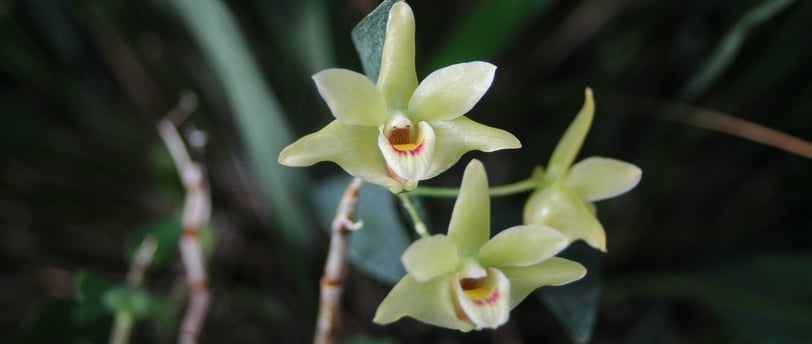A Comprehensive Guide to Growing Dendrobium Catenatum
Yun Ai
4/4/20243 min read


Introduction
Dendrobium Catenatum, commonly known as the Singapore Dendrobium, is a stunning orchid species that has captured the hearts of many enthusiasts around the world. With its vibrant colors and delicate blooms, this orchid is a true gem in any collection. In this guide, we will explore the cultivation and care of Dendrobium Catenatum, helping you unlock the secrets to successfully growing this beautiful orchid.
Understanding Dendrobium Catenatum
Dendrobium Catenatum is native to Southeast Asia, particularly Singapore and Malaysia. It is a epiphytic orchid, meaning it naturally grows on trees, using their branches for support. This orchid is known for its long, slender pseudobulbs and arching, lance-shaped leaves. The flowers of Dendrobium Catenatum are truly a sight to behold, with their vibrant colors ranging from white and pink to purple and yellow.
Creating the Ideal Growing Conditions
Providing the right growing conditions is crucial for the successful cultivation of Dendrobium Catenatum. Here are some key factors to consider:
Light
Dendrobium Catenatum thrives in bright, indirect light. Place your orchid near a window with filtered sunlight or provide artificial lighting with full spectrum grow lights. Avoid placing the orchid in direct sunlight, as this can scorch the leaves and flowers.
Temperature
This orchid species prefers warm to intermediate temperatures, ranging from 65°F to 85°F (18°C to 29°C) during the day and a slight drop in temperature at night. Avoid exposing Dendrobium Catenatum to extreme temperature fluctuations, as this can cause stress and hinder its growth.
Air Circulation
Good air circulation is essential for the health of Dendrobium Catenatum. Provide gentle air movement through the use of fans or by placing the orchid in a well-ventilated area. This will help prevent the buildup of moisture and reduce the risk of fungal diseases.
Humidity
As a tropical orchid, Dendrobium Catenatum thrives in high humidity. Aim for a humidity level of around 60% to 70%. If the air in your home is dry, you can increase humidity by using a humidifier or placing the orchid on a tray filled with water and pebbles.
Potting and Repotting
Proper potting is essential for the health and growth of Dendrobium Catenatum. Here's what you need to know:
Potting Medium
Use a well-draining potting medium for Dendrobium Catenatum, such as a mixture of orchid bark, sphagnum moss, and perlite. This will allow excess water to drain away quickly, preventing the roots from sitting in soggy conditions.
Pot Size
Choose a pot that is just slightly larger than the orchid's root system. Dendrobium Catenatum prefers to be slightly pot-bound, as this mimics its natural growing conditions and promotes better blooming.
Repotting
Repot Dendrobium Catenatum every 2 to 3 years, or when the potting medium starts to break down and become compacted. Spring is the best time to repot, as the orchid is entering its active growth phase. When repotting, gently remove the orchid from its current pot, trim any dead or damaged roots, and place it in a new pot with fresh potting medium.
Watering and Fertilizing
Proper watering and fertilizing practices are crucial for the health and vitality of Dendrobium Catenatum. Here's what you need to know:
Watering
Water Dendrobium Catenatum thoroughly when the potting medium is almost dry. Stick your finger about an inch into the medium to check for moisture. If it feels dry, it's time to water. Avoid overwatering, as this can lead to root rot. Allow the excess water to drain away completely.
Fertilizing
Feed Dendrobium Catenatum with a balanced orchid fertilizer every 2 weeks during the growing season (spring and summer). Use a diluted solution and follow the instructions on the fertilizer package. During the dormant season (fall and winter), reduce fertilization to once a month or suspend it altogether.
Common Pests and Diseases
While Dendrobium Catenatum is generally a hardy orchid, it can still be susceptible to certain pests and diseases. Here are a few common ones to watch out for:
Scale Insects
Scale insects are small, oval-shaped pests that attach themselves to the leaves and stems of orchids. They can be difficult to eradicate, so it's important to catch them early. Use a cotton swab dipped in rubbing alcohol to remove the scales manually, or apply an insecticidal soap according to the manufacturer's instructions.
Mealybugs
Mealybugs are white, cottony pests that feed on the sap of orchids. They can cause stunted growth and yellowing of leaves. Remove mealybugs by dabbing them with a cotton swab soaked in rubbing alcohol, or use an insecticidal soap.
Root Rot
Overwatering or poor drainage can lead to root rot in Dendrobium Catenatum. If you notice mushy, discolored roots, it's a sign of root rot. Trim away the affected roots and repot the orchid in fresh, well-draining medium.
Conclusion
Cultivating and caring for Dendrobium Catenatum can be a rewarding experience for any orchid enthusiast. By providing the right growing conditions, potting the orchid correctly, and maintaining proper watering and fertilizing practices, you can enjoy the beauty of this stunning orchid species for years to come. Remember to keep an eye out for pests and diseases, and address them promptly to ensure the health and vitality of your Dendrobium Catenatum. Happy growing!
